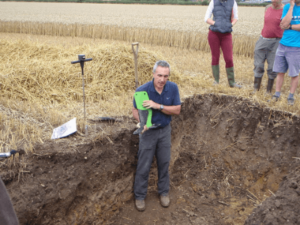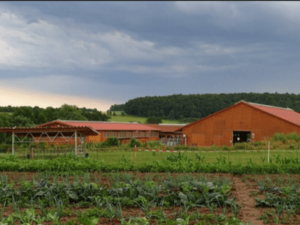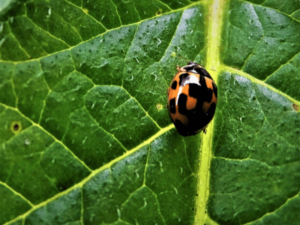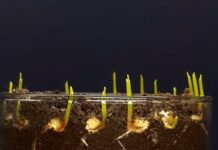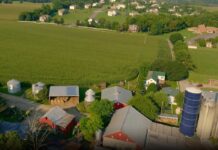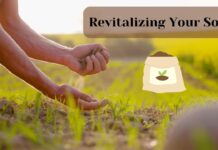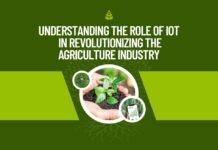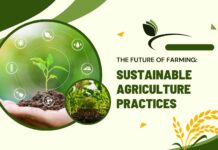
What is Organic Farming?
Organic farming is a technique that inherently includes crop production and animal rearing. This process involves the use of biological materials to avoid artificial chemicals in order to maintain soil fertility and ecological balance and thus reduce contamination and waste. In other words, the Organic Farming Method involves growing and nurturing crops without the use of fertilizers and pesticides based on synthetics. It is also not allowed to have genetically modified organisms.
Methods of Organic Farming
No matter how much a man progresses, agriculture is an occupation that was, is and will always be undertaken, since it suffices one of the most important basic needs of the population, which is Food. Hence, technology is added in this field to find ways to increase agricultural production in order to feed the ever-growing demand for food due to the drastic increase in population. Therefore, many new ways and methods are being introduced in this field to harvest and cultivate the best quality crops.
Organic farming can be explained as an agricultural method wherein the following techniques are used:
- Crop Rotation: A technique to grow various kinds of crops in the same area, according to different seasons, in a sequential manner
- Green Manure: Refers to the dying plants that are uprooted and stuffed into the soil in order to make them act as a nutrient for the soil to increase its quality
- Biological Pest Control: A method in which living organisms are used to control pests, without or with limited use of chemicals
- Compost: Highly rich in nutrients, this is a recycled organic matter used as a fertilizer in the agricultural farms
The reason why organic agriculture is enforced in many nations is that it minimizes the use of various harmful chemicals that have hazardous effects on crops in the field. Here, there is more focus on using natural ways to enhance the quality of soil and cultivated crops. Organic agriculture is nothing more than a modernization in agriculture. It is a combination of science, technology, and nature. Following are the different methods that combine together to form organic agriculture:
Crop Diversity
Earlier, Monoculture was the only practice used in the agricultural fields wherein only one type of crop was harvested and cultivated in a particular location. However, in the recent world, Polyculture has come into the picture wherein different kinds of crops are harvested and cultivated in order to meet the increasing crop demand and produce the required soil microorganisms.
Soil Management
After the season of cultivation has been conducted, the soil loses its nutrients and becomes less in quality. Rather than using harmful chemicals to enhance this soil, organic agriculture focuses on implementing natural ways to not only increase the health of soil but also keep the nature and human health unharmed. One of the best examples of natural ways to enhance soil is the use of bacteria that is present in animal waste. This bacteria helps in making the soil nutrients more productive; much higher as compared to the chemical containing liquids.
Weed Management
“Weed”, in simple words, is nothing but the unwanted plant that grows in agricultural fields. However, in organic agriculture, there is more focus on suppressing the weed rather than eliminating it completely.
The two most widely used weed management techniques are:
- Mulching – a process wherein plastic films are used in order to block the growth of weed
- Mowing and cutting – wherein there is a removal of weeds’ top growth
Also, See Top 7 Best Organic Weed Killer for Garden & Lawn in 2024
Controlling other organisms
While certain organisms prove to be beneficial to the health of the agricultural farm, there are many others that hamper the field. Hence, the growth of such organisms needs to be controlled to protect the soil and crops. Out of the long list, the following are the three most commonly used and important ways of controlling other organisms in organic agriculture:
- Encouraging ladybugs, minute pirate bugs and other such predatory beneficial insects that feast on pests and fly away from the farm.
- Using herbicides and pesticides that are natural or contain less chemical.
- Proper sanitization of the entire farm in order to keep it free from pests.
Livestock
There can be no better place for the pet animals to get fresh air, food and a great exercise than the green farm. Since everything is preferred to be in a natural way, just like the animals were used as labor in the earlier times for plowing, organic agriculture encourages the use of domestic animals to increase the sustainability of the farm.
Also, See An Ultimate Guide on Goat Farming in India
Genetic Modification
Since organic agriculture encourages the use of natural ways to enhance the farm, crops, and soil; there is a discouragement of genetically engineered animals and plants. Hence, genetic modification is kept out of this agriculture. However, there is an argument keeping in mind that the pollen present in such modified crops are present in the stock of seeds used for organic agriculture, making it impossible to keep this completely out of organic agriculture.
Organic agriculture is being conducted by many countries with the rejection of using techniques and chemicals that harm animals, crops, soil, environment, and even human health. Hence, such a process of agriculture should be encouraged since it acts as a protective shield to all the main factors that form the planet.
- Biological pest control
- compost
- crop-rotation
- green manure
- Methods
- Organic Farming
Organic Farming Methods
Conversion Period
If the farmers practice traditional agriculture and the field is not completely organic, the farmer must have a conversion strategy. The’ conversion’ period is the time span between the start of organic operations and certification. Taking into account the history of the land and its past use, the exact time period is determined. Often important is the transition time if the area is partly organic. Nevertheless, it is important to clearly mark and maintain the organic and inorganic fields separately. Gradually, the whole farm, including the pet, must be transformed into organic over a period of time. The transition time is on average for perennials for three years and for annuals for two years.
Mixed Farming
This is an agricultural activity in which there is not only plant production but also other agriculture such as animal husbandry, sericulture, fish farming and fish farming, poultry management, etc. In other words, mixed farming means incorporating animals into the agricultural system in order to ensure soil Biological Fertilizers and crop yield.
Planting in Organic Farming
Farmers sometimes forget they have to plant what the area’s environment, atmosphere, and soil requires. They have to produce what’s natural to the soil. If not, it is important to adapt the species or variety selected for cultivation to the soil. It is necessary to obtain the planting material and seeds from a reliable source certified organic by the approving body. In the absence of’ natural’ crops, chemically processed planting material should be used. It is also not allowed to grow pollen seeds, tissue seeds, transgenic crops, genetically engineered seeds.
Pest and Disease Management
Using’ natural’ is forbidden, as the term means using artificial fungicides, weedicides, pesticides. Natural pest enemies are cultivated and protected. Planting a tree on the farm or building a bird nest, for example, will promote bird development. Birds are insect pests ‘ natural enemies. The insects are therefore handled in a natural manner. It is illegal to control diseases and insects using genetically engineered species. Manual weeding cycle is done for weeds. In the field, weeds near the plant base are harvested and reused as mulch. Plant-based repellents, extracts from the neem seed kernel, mechanical traps, pheromone traps, clay, soft soap, and chromatic traps are required for farm use. In case of absolute necessity, it is appropriate to contact the certifying agency and use the following products.
Also, See The 10 Best Organic Lawn Fertilizer in 2024
Conclusion
To conclude, organic farming in India is a safe undertaking, while developing and becoming fully functional may take a while. The commercial aspects of government subsidies are available. If organic farming methods can be followed strictly, the appropriate organic certification is acquired and the right market is available, then organic farming in India is very profitable.
Top 10 Reasons to go Organic
1. Only organic guarantees…
Organic is the food system most heavily regulated in the USA. Only organic guarantees do not use toxic persistent pesticides, synthetic fertilizers or GMOs in production, and livestock is not given antibiotics or growth hormones. Organic growers and processors are subject to comprehensive confirmed – and unannounced – certification inspections by third-party inspectors to ensure that organic goods are produced and processed in a manner in which you and your family can have trust.
2. More nutritious
The latest studies have shown that organic fruits, vegetables, and grains have more antioxidants, fewer nitrates and cadmium, and less residues of pesticides than non-organic crops.
3. Helps combat climate change
Organic farming methods help keep our soil intact. Naturally, healthy soil retains photosynthesized carbon dioxide, rather than releasing it back into the atmosphere. The consistency helps in the fight against climate change.
4. Fewer pesticides
Organic food shall be grown without the use of systemic pesticides. One of the best ways to reduce your exposure to these toxic chemicals is to eat organic foods.
5. GMO-free
Buying organic is the best way of ensuring your food is GMO-free. The cultivation and processing of organic foods are banned against GMOs.
6. Fewer synthetic fertilizers
The use of most synthetic fertilizers is prohibited on organic farmers. They preserve their soil quality through the use of manure, compost, and other organic materials. Up to 40% of the synthetic fertilizers used on traditional farms end up in land and surface waters, which ultimately pollute rivers, lakes, and oceans.
7. No sewage sludge
Most modern farmers spread sewage sludge onto their fields as fertilizer. Sewage sludge contains everything in the wastewater system that is washed, drained, or dumped into. Organic farmers are prohibited to use waste sludge on their grounds.
8. Antibiotic-free meat
The overuse of antibiotics to promote growth in traditional livestock production has led to the emergence of some harmful microbes with antibiotic-resistant strains. Organic farmers will only treat animals with antibiotics as a last resort for diseased animals and animals undergoing antibiotic care lose their organic certification. That helps to preserve the effectiveness of human vital antibiotics.
9. Hormone-free meat
Conventional farmers are briefly giving growth hormones to the cows to improve milk production. Such hormones can affect cow fertility and contribute to clinically irregular disorders in milk and hoof. Hormone-treated cow’s milk has been linked to increased human cancer risk.
10. Humane animal treatment
Organic farmers and ranchers must meet their livestock ‘s natural actions and fulfill health and wellness needs, including year-round outdoor exposure, space for exercise, clean and dry bedding, clean water, shelter, and direct sunlight.
Also, See Top 7 Best Organic Weed Killer for Garden & Lawn in 2024

